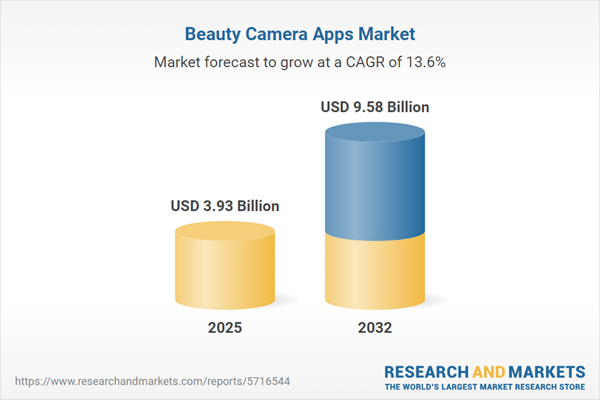Speak directly to the analyst to clarify any post sales queries you may have.
Senior executives overseeing growth in the beauty camera apps market are contending with dynamic digital shifts and heightened user expectations. Swift adaptation and ongoing innovation are essential for enterprises to secure long-term relevance in a globally competitive landscape.
Market Snapshot: Global Beauty Camera Apps Market Dynamics
The global beauty camera apps market is valued at USD 3.46 billion in 2024 and projected to reach USD 9.58 billion by 2032, supported by a strong 13.56% CAGR. Key drivers include rapid advances in augmented reality (AR), which enable sophisticated cosmetic simulations and deeper digital engagement across brand-user interactions. This evolving technology landscape prompts brands to invest in localized digital experiences. Enhanced imaging capabilities and alignment with new standards fuel feature development, supporting greater user loyalty. As competition deepens, delivering consistent improvements and tailored user journeys becomes a clear differentiator for growth-minded organizations.
Scope & Segmentation: Strategic Perspectives for Beauty Camera Apps
This report delivers a clear segmentation analysis for organizations navigating digital imaging and app-based beauty solutions. Senior decision-makers will benefit from a thorough assessment of technology adoption, demographic influence, and creative revenue strategies. Insights enable sharper market forecasts, improved positioning, and streamlined stakeholder alignment.
- Operating System: Includes examination of performance and user experience across Android and iOS, analyzing how tailored interfaces and adapting functional features shape cross-platform satisfaction and long-term retention.
- Monetization Model: Evaluates the business impact of free, freemium, and premium models, focusing on how strategic offering structures, appropriate pricing, and selective feature access attract different customer segments for expansion.
- Feature Type: Reviews the adoption of AR filters, facial recognition, skin analysis, and virtual makeup, underscoring their importance in product differentiation and sustained value generation within a crowded market.
- User Age Group: Profiles key demand patterns among core cohorts (18–24, 25–34, 35–44, 45+), providing insight for product refinement and precise outreach strategies tailored to evolving user motivators within each age group.
- Region: Maps out strategic variations across the Americas, Europe, Middle East & Africa, and Asia-Pacific, with attention to the roles of cultural nuance, regulatory compliance, and region-specific opportunities for deployment.
- Key Companies Analyzed: Benchmarks major players such as Meitu, SNOW Corp., Perfect Corp., Lightricks Ltd., Beijing Xiaoxi Network Technology, PicsArt, VSCO Labs, Adobe, Ulike Limited, JP Brothers Inc., Claranova SE, InShot Inc., and TOGL Technology Sdn Bhd—highlighting competitive strengths and partnership opportunities.
Key Takeaways for Senior Decision-Makers
- AR-driven and highly interactive features are prompting market leaders to advance their technology roadmaps, improving engagement and customer experience.
- Integrating advanced imaging tools within well-established social media platforms helps brands target diverse audiences more effectively and reinforces digital influence across user communities.
- Prioritizing robust privacy practices and regulatory compliance strengthens organizational credibility and simplifies entry into highly regulated regions, reducing business risk.
- Adopting modular app architectures allows organizations to pivot quickly as new technologies and user requirements emerge, maintaining agility and reducing time to market.
- Collaboration between app developers and device manufacturers unlocks new growth avenues, expanding reach and delivering early-mover benefits through wider distribution agreements.
- Detailed segmentation supports alignment between product design and varying demographic and regional compliance needs, enabling sharper go-to-market strategies.
Tariff Impact: Regulatory and Supply Chain Considerations
Shifting U.S. trade policies are influencing access to critical camera chipsets and sensor components. Organizations are addressing these challenges by diversifying supplier relationships, moving manufacturing to more stable regions, and bolstering proprietary R&D initiatives. These approaches, combined with proactive inventory management, are helping businesses maintain innovation as global trade and supply landscapes shift.
Methodology & Data Sources
Report findings are derived from executive interviews, proprietary analytics, and broad-based secondary research. Scenario-based forecasting informs risk and opportunity assessments, offering decision-makers practical knowledge for navigating today’s digital imaging industry.
Why This Report Matters: Actionable Intelligence for B2B Leaders
- Supports the development of precise strategies in response to evolving regulatory and technology trends in the digital imaging market.
- Keeps organizations informed on sector advancements, regional market nuances, and competitor activities to strengthen confident decision-making.
- Equips leaders with segmentation insights, enabling optimized resource allocation and business model selection aligned with changing expectations.
Conclusion
The beauty camera apps sector is undergoing significant digital transformation. This report offers senior leaders focused market intelligence, enabling steady adaptation and effective navigation of emerging challenges.
Additional Product Information:
- Purchase of this report includes 1 year online access with quarterly updates.
- This report can be updated on request. Please contact our Customer Experience team using the Ask a Question widget on our website.
Table of Contents
3. Executive Summary
4. Market Overview
7. Cumulative Impact of Artificial Intelligence 2025
Companies Mentioned
The companies profiled in this Beauty Camera Apps market report include:- Meitu, Inc.
- SNOW Corp.
- Perfect Corp.
- Lightricks Ltd.
- Beijing Xiaoxi Network Technology Co., Ltd.
- PicsArt, Inc.
- VSCO Labs LLC
- Adobe Inc.
- Ulike Limited
- JP Brothers Inc.
- Claranova SE
- InShot lnc.
- Lightricks Ltd.
- Meitu Inc.
- TOGL Technology Sdn Bhd
Table Information
| Report Attribute | Details |
|---|---|
| No. of Pages | 181 |
| Published | October 2025 |
| Forecast Period | 2025 - 2032 |
| Estimated Market Value ( USD | $ 3.93 Billion |
| Forecasted Market Value ( USD | $ 9.58 Billion |
| Compound Annual Growth Rate | 13.5% |
| Regions Covered | Global |
| No. of Companies Mentioned | 16 |









